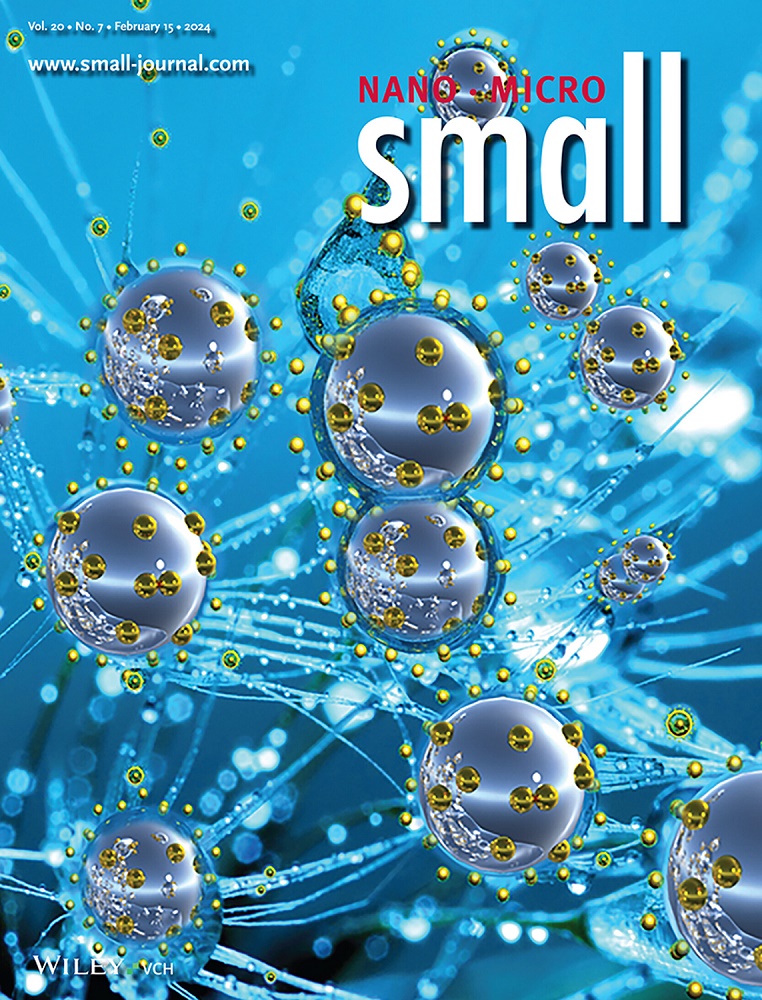Multidentate Chirality Inducers in the Synthesis of Intrinsically Chiral Gold Nanoparticles: Effects of Multiplicity and Spatial Distribution of Cysteine.
IF 13
2区 材料科学
Q1 CHEMISTRY, MULTIDISCIPLINARY
引用次数: 0
Abstract
Nanomaterials with chiral shapes have the potential to revolutionize medicine, communication technologies, and electronics. However, their syntheses usually rely on chirality inducers of natural origin, restricting the development of chiral nanomaterials. Here, multidentate hybrid organic compounds are introduced as a novel approach to effective symmetry breaking in the synthesis of chiral Au nanoparticles (NPs). Natural and synthetic chemical motifs within a single molecule are integrated by attaching cysteine (Cys) moieties to aromatic units. Au NPs synthesized using these chirality inducers exhibit fourfold rotational symmetry with varied spikiness as evidenced by transmission electron tomography. Optimized samples exhibit high dissymmetry values, g-factor of the order of 10-2. This is notable given the small size of NPs, less than 130 nm in length and 90 nm in width. By varying the inducers' architecture, it is uncovered that the multiplicity of Cys units and the type of the central aromatic units are crucial to the effectiveness of chirality induction. The reproducibility of the synthetic procedure is also verified. These findings represent a substantial evolution from the classical chiral inducers of natural origin. They promise to advance enantioselective synthesis by uncovering molecular design principles of chirality inducers that affect chirality transfer between organic and inorganic materials.多齿手性诱导剂在合成固有手性金纳米粒子中的应用:半胱氨酸的多样性和空间分布的影响。
具有手性形状的纳米材料具有彻底改变医学、通信技术和电子技术的潜力。然而,它们的合成通常依赖于天然的手性诱导剂,这限制了手性纳米材料的发展。本文介绍了多齿杂化有机化合物作为手性金纳米颗粒合成中有效对称性破缺的一种新方法。天然的和合成的化学基序在单个分子内是通过将半胱氨酸(Cys)部分连接到芳香单元来整合的。利用这些手性诱导剂合成的金纳米粒子表现出四重旋转对称性,具有不同的尖状物,这在透射电子断层扫描中得到了证明。优化后的样品具有较高的不对称值,g因子为10-2。考虑到NPs的小尺寸,长度小于130纳米,宽度小于90纳米,这一点值得注意。通过改变诱导剂的结构,揭示了Cys单元的多样性和中心芳香单元的类型对手性诱导的有效性至关重要。合成过程的重现性也得到了验证。这些发现代表了从自然起源的经典手性诱导剂的实质性进化。他们承诺通过揭示影响有机和无机材料之间手性转移的手性诱导剂的分子设计原理来推进对映选择性合成。
本文章由计算机程序翻译,如有差异,请以英文原文为准。
求助全文
约1分钟内获得全文
求助全文
来源期刊

Small
工程技术-材料科学:综合
CiteScore
17.70
自引率
3.80%
发文量
1830
审稿时长
2.1 months
期刊介绍:
Small serves as an exceptional platform for both experimental and theoretical studies in fundamental and applied interdisciplinary research at the nano- and microscale. The journal offers a compelling mix of peer-reviewed Research Articles, Reviews, Perspectives, and Comments.
With a remarkable 2022 Journal Impact Factor of 13.3 (Journal Citation Reports from Clarivate Analytics, 2023), Small remains among the top multidisciplinary journals, covering a wide range of topics at the interface of materials science, chemistry, physics, engineering, medicine, and biology.
Small's readership includes biochemists, biologists, biomedical scientists, chemists, engineers, information technologists, materials scientists, physicists, and theoreticians alike.
 求助内容:
求助内容: 应助结果提醒方式:
应助结果提醒方式:


